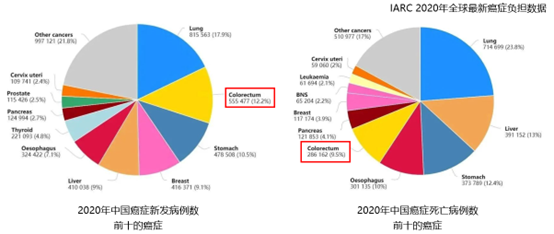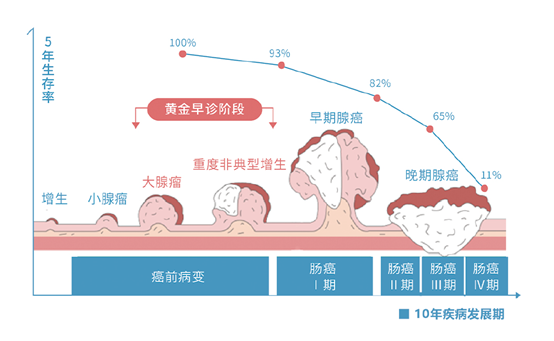Current location: Home > NEWS > Industry news
NEWS
PRODUCTS
More than 85% of colorectal cancers are found at an advanced stage. How to detect colorectal cancer early?
News source: Release time:[2022-09-13]
Part 1
Status of early screening and early diagnosis of colorectal cancer
Colorectal cancer (CRC) is one of the most common malignant tumors. Its incidence rate ranks third among malignant tumors and the mortality rate ranks second in the world. people's life and health [1].
In recent years, with the westernization of my country's lifestyle and diet structure, the incidence of colorectal cancer has generally shown an upward trend. Research data shows that the number of new CRC cases in my country has increased from 388,000 in 2015 to 560,000 in 2020. The number of deaths increased from 187,000 in 2015 to 290,000 in 2020, with a five-year growth rate of 55.1%[1][2]. CRC has become the second most common cancer with the fifth highest mortality rate in my country [1]. Therefore, reducing the mortality and morbidity of colorectal cancer in my country is not only a major clinical key issue without delay, but also a concrete measure to realize the grand strategy of "Healthy China" in the report of the 19th National Congress of the Communist Party of China.

▲IARC 2020 latest global cancer burden data[1]
Part 2
The development of colorectal cancer
The evolution of colorectal cancer is mainly through the inflammatory carcinogenesis pathway, including: adenomatous polyp-carcinoma pathway, serrated polyp-carcinogenesis pathway and de novo pathway [3]. It can be seen that its occurrence and development are closely related to colon polyps. The occurrence and development of colorectal cancer mostly follow the development process of "polyp-adenoma-cancer". It generally takes 5-10 years or even longer to progress from precancerous lesions to cancer, which provides valuable information for early diagnosis and clinical intervention of the disease. time.

▲CRC disease progression
Part 3
Current status of early diagnosis of colorectal cancer in China
At present, the 5-year survival rate of colorectal cancer in China is much lower than that of the United States, Japan and South Korea. More than 85% of colorectal cancers are found at an advanced stage. Even after comprehensive treatment such as surgery, radiotherapy and chemotherapy, and targeted therapy, the 5-year survival rate of patients is still Significantly lower than 40%; on the contrary, the 5-year survival rate after treatment for early-stage colorectal cancer can exceed 95%, and even complete cure.
At present, the diagnosis rate of early colorectal cancer in my country is less than 10%, which is significantly behind Japan (the early diagnosis rate reached 20% in 1991) and South Korea (over 20% in 2009). Therefore, in order to change the current situation of high morbidity, high mortality and low early diagnosis rate of colorectal cancer in China, early colorectal cancer screening measures need to be promoted in China.
Part 4
Current common clinical screening methods for colorectal cancer
At present, there are various methods for early screening of colorectal cancer. The mainstream methods are tumor markers, fecal occult blood test (FOBT), fecal DNA testing, Septin9 gene methylation testing, and colorectal endoscopy. [4]
At present, the most commonly used serological tumor markers related to the digestive tract include: alpha-fetoprotein (AFP), carcinoembryonic antigen (CEA), sugar chain antigens (CA199, CA724, CA125), etc., but these tumor markers are very important for colorectal cancer The sensitivity and specificity of diagnosis are not ideal [5].
FOBT is the most important method for non-invasive screening of colorectal cancer, including chemical and immunochemical methods. This method has the advantages of low price and convenient inspection, and the participation rate of population screening is relatively high. However, this method has low sensitivity in detecting colorectal cancer and its precancerous lesions, and is easily interfered by various factors such as food and drugs, and the false positive rate is relatively high.
Stool DNA detection is mainly aimed at the characteristics of gene mutation and/or methylation of colorectal exfoliated cells. There are single-target and multi-target solutions, and it can also be detected in combination with FIT. It does not require special equipment, diet, and non-invasive methods. There are other advantages, but the price is high, the sampling amount is too much or too little or the water sample may affect the test results.
Pathological examination of colonoscopic biopsy or resection specimens is the gold standard for the diagnosis of colorectal cancer, and microscopic resection of precancerous lesions can reduce the morbidity and mortality of colorectal cancer. Because it can directly observe the inner wall of the colorectal cavity, it is the most sensitive method for detecting intestinal tumors, but there is still a certain missed diagnosis rate in colorectal endoscopy. Microscopic observation to reduce the rate of missed diagnosis of lesions. It is worth mentioning that because of the need for dietary restrictions and strict bowel cleansing preparations before colonoscopy, and because it is an invasive test, it will suffer a lot of pain, so the compliance of the subjects is poor.
Septin9 gene methylation detection is a non-invasive and non-invasive technique for early screening, auxiliary diagnosis and curative effect monitoring of CRC. The detection of Septin9 gene methylation status on blood ctDNA can assist in diagnosis and detect ultra-early colorectal cancer lesions, which can theoretically warn the risk of CRC 3 to 5 years in advance. It has the characteristics of high sensitivity, high specificity, good compliance, convenient sampling, and only needs peripheral blood.
Summarize
Colorectal cancer is not a sudden disease, we have enough time to find it and treat it before it develops into colorectal cancer. Early detection, early diagnosis, and early treatment are the most important cancer prevention measures. We can eliminate colorectal cancer in the bud through early screening and intervention. At the same time, we need to improve personal cancer prevention awareness, change bad lifestyle and eating habits, enhance immunity, and build a healthy shield for the body.
References
[1] IARC 2020 latest global cancer burden data
[2]Chinese Journal of Oncology, 2019, 41(1):19-28.
[3] A. S. Gordon et al., "Rates of Actionable Genetic Findings in Individuals with Colorectal Cancer or Polyps Ascertained from a Community Medical Setting," Am J Hum Genet, vol. 105, no. 3, pp. 526-533, Sep 5 2019, doi: 10.1016/j.ajhg.2019.07.012.
[4] Expert consensus on early colorectal cancer screening process in China (2019, Shanghai)
[5] H. Rao, H. Wu, Q. Huang, Z. Yu, and Z. Zhong, "Clinical Value of Serum CEA, CA24-2 and CA19-9 in Patients with Colorectal Cancer," Clin Lab, vol. 67, no. 4, Apr 1 2021, doi: 10.7754/Clin.Lab.2020.200828.